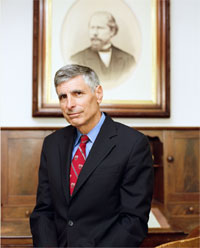FALL 2008 CONTENTS
Home
Prognosis: uncertain
Overhauling the health-care system
SOS NIH
A wake-up call to all who care about science—or for that matter, prosperity
California dreamin’
The Golden State’s golden opportunity
The real issues in health-care reform
Beyond the rhetoric
Bread, butter, and universal health care
Safeway’s CEO talks reform
Armies of the status quo
The Washington health-care lobby
Back to back: Gingrich and Wyden
A Republican and a Democrat weigh in on health-care reform
An open letter to the new president
Science matters
NETworking
Fighting for children’s health inside the hospital and out


Leslie Williamson

Philip Pizzo with a portrait of Levi Cooper Lane, The Founder of Cooper Medical College, which became Stanford Medical School.
Physicians by and large do not vote. And, quite frankly, this astonishes me. But the data paint a bleak picture: If voting patterns continue to reflect those of the last decades, only about 40 percent of doctors will vote in the upcoming U.S. presidential election. An analysis reported last year in the Journal of General Internal Medicine found that the probability of a doctor voting in national elections from 1996 to 2000 was 41.5 percent, while the likelihood for the general public was 50.2 percent. The researchers found similar physician voting patterns as far back as the late 1970s — the limit for their data.
Does it matter? Well, I think so. Increasingly, medical and scientific issues are moving into the public arena for debate and action by voters. From creationist candidates running for school board, to state ballot measures funding large-scale science initiatives, to proposals to fix our mangled health-care system, the public is making choices with repercussions for science education, biomedical research and our very health. If physicians reject participation in the electoral process, we miss input from an important sector of the voting public.
As the November election comes into full view, I hope you’ll find this special issue of Stanford Medicine valuable. Nobel laureate Roger Kornberg writes eloquently about his disquiet over the federal government’s decreasing financial commitment to basic research and urges scientists to press for policy change. The issue also airs views from outside Stanford, with Democratic Sen. Ron Wyden of Oregon (a Stanford alum) and former House Speaker Newt Gingrich offering paths out of the health-care crisis; Kaiser Family Foundation’s CEO, Drew Altman, taking a hard look at public sentiment about health-care reform; and Safeway’s CEO, Steven Burd, an unlikely reform evangelist, explaining why universal health care makes good business sense.
Finally, a word about the magazine’s cover. It might look like Stanford Medicine has a candidate in mind, as one of the nominees is hidden behind the title flap. But which candidate? On half of this issue’s print run, the front flap hides Sen. McCain’s image, on the other half, Sen. Obama’s is undercover. There’s no subliminal message here — even though I certainly have a definite point of view. But true to our mission: We provide the facts objectively, you decide.
So whatever your choice, get involved, take a stand and get out there and vote. Much is at stake.
Sincerely,
Philip A. Pizzo, MD
Dean
Stanford University School of Medicine
Carl and Elizabeth Naumann Professor, Pediatrics, Microbiology and Immunology

